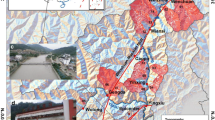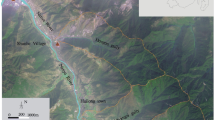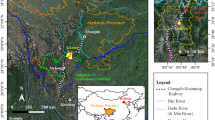Abstract
About 127 debris flow gullies have been identified, and debris flows have been an important type of geological hazards in Luding County, affecting cities, towns, rural areas, scenic spots and human’s engineering projects, such as mining and waterpower utilizing equipments. In this summary paper, recent two catastrophic debris flow events occurred on June 30, 2005, in Chuni town, in the central of the county, and on August 11, 2005, in Hailuogou scenic spot, in the southwest of the county, respectively, are reviewed. The debris flow events are introduced on the basis of field investigation and RS interpretation and the triggering factors for flow occurrence are identified. Furthermore, the rainfall related to flow occurrence including antecedent rainfall and intraday rainfall is analyzed, and a power-law function which can be used as a basic warning line is established based on both antecedent effective rainfall and intraday rainfall. Then dynamic parameters such as flow velocity and flow discharge are calculated, respectively. Through comparison and discussion, some conclusions are made including (1) The antecedent rainfall played an important role for debris flows which generated predominately based on the slope-instability due to the saturated loose sediments; (2) Despite slower flow velocity and smaller magnitude, the slope-type debris flows just like 2005-6-30 debris flows usually lead to serious damages for the difficulty to forecast and to prevent; (3) The mistaken recognition on debris flow hazards and lack of prevention consciousness strengthen the hazard and damage degree. This research is of certain significance for the prevention and mitigation of debris flow hazards and for the planning of the town building and tourism development in the future.













Similar content being viewed by others
References
Berti M, Genevois R, Simoni A (2005) Experimental evidences and numerical modeling of debris flows initiated by channel runoff. Landslides 2:171–182
Bruce J, Clark R (1969) Introduction to hydrometeorology. Pergamon Press, London, pp 252–270
Caine N (1980) The rainfall intensity-duration control of shallow landslides and debris flows. Geografiska Annaler 62A:23–27
Cannon S, Gartner J, Wilson R (2008) Storm rainfall conditions for floods and debris flows from recently burned areas in southwestern Colorado and southern California. Geomorphology 96:250–269
Chen H, Dadson S, Chi Y (2006a) Recent rainfall-induced landslides and debris flows in northern Taiwan. Geomorphology 77:112–125
Chen X, Cui P, Chen B, Qi Y (2006b) 050811 Large-scale debris flow in Hailuo valley and preventjon countermeasures. Bull soil water conserv 26(3):122–126 (in Chinese)
Cong W, Pan M, Li T, Ren Q, Li R (2006) Quantitative analysis of critical rainfall-triggered debris flows. Chin J Rock Mech Eng 25:2808–2812 (in Chinese)
Cui P, Wei F, Xie H, Yang K, He Y, Ma D (2003) Debris flow and disaster reduction strategies in western China. Quat Sci 23(2):142–151 (in Chinese)
Curry R (1966) Observations of Alpine mudflows in the Tenmile range, Central Colorado. Geol Soc Am Bull 77:771–777
Fiorillo F, Wilson R (2004) Rainfall induced debris flows in pyroclastic deposits, Campania (Southern Italy). Eng Geol 75:263–289
Fryxell F, Horberg L (1943) Alpine mudflows in Grand Teton National Park, Wyoming. Geol Soc Am Bull 54:457–472
Glade T, Crozier MJ, Smith P (2000) Applying probability determination to refine landslide-triggering rainfall thresholds using an empirical “Antecedent Daily Rainfall Model”. Pure Appl Geophys 157:1059–1079
Godt J, Coe J (2007) Alpine debris flows triggered by a 28 July 1999 thunderstorm in the central Front Range, Colorado. Geomorphology 84:80–97
Guzzetti F, Peruccacci S, Rossi M, Stark C (2008) The rainfall intensity-duration control of shallow landslides and debris flows: an update. Landslides 5:3–17
Hungr O, Evans S, Bovis M et al (2001) A review of the classification of landslides of the flow type. Environ Eng Geosci 7(3):221–238
Hürlimann M, Rickenmann D, Graf C (2003) Field and monitoring data of debris-flow events in the Swiss Alps. Can Geotech J 40:161–175
Liu X, Zhao Y, Ni H, Chen Y, Wang M (2006) Investigation and assessment of group debris flows on June 30, 2005 in Luding County, Sichuan. J Catastrophology 21(4):58–65 (in Chinese)
Lu Z, Jia S, Huang K (1991) Drainage geomorphology system. Dalian press, Dalian (in Chinese)
Ni H, Li Z, Ba R, Su P, Song Z (2007) Preliminary study on the critical rainfall condition of debris flows along Moxi river in the east slopes of the Mount Gongga. J Mt Sci 25(6):721–728 (in Chinese)
Pelfini M, Santilli M (2008) Frequency of debris flows and their relation with precipitation: a case study in the Central Alps, Italy. Geomorphology 101:721–730
Seplveda S, Rebolledo S, Vargas G (2006) Recent catastrophic debris flows in Chile: geological hazard, climatic relationships and human response. Quat Int 158:23–95
Sepúlveda S (2000) Methodology for debris flow hazard evaluation in mountainous environments. Comunicaciones 51:3–18
Shen Y, Gong G (1986) Conspectus of river geomorphology. Science press, Beijing (in Chinese)
Zhou B, Li D, Luo D (1991) Prevention guide for debris flow. Science press, Beijing (in Chinese)
Acknowledgments
The authors gratefully acknowledge the financial assistance provided by China Geology Survey (Project No. 1212010640503) and Science Foundation for Young Scholar from CDCGS (2009–2010). Great thanks are given to Prof. Bingyan Tan and Prof. Xilin Liu for their guidence during fieldwork, to Prof. Jinghua Zhang for his help in dealing with RS explanation and to Yujie Liu and Zhi Song who surveyed partial debris flow gullies during field investigation. The authors would like to give their special thanks to Prof. Thomas Glade and two anonymous reviewers for their comments.
Author information
Authors and Affiliations
Corresponding author
Rights and permissions
About this article
Cite this article
Ni, H., Zheng, W., Li, Z. et al. Recent catastrophic debris flows in Luding county, SW China: geological hazards, rainfall analysis and dynamic characteristics. Nat Hazards 55, 523–542 (2010). https://doi.org/10.1007/s11069-010-9545-2
Received:
Accepted:
Published:
Issue Date:
DOI: https://doi.org/10.1007/s11069-010-9545-2




